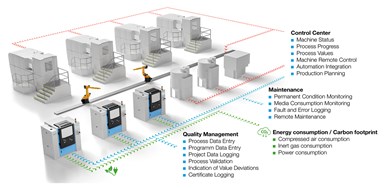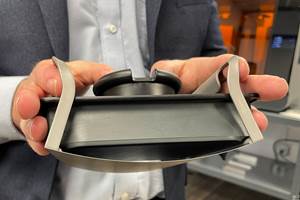Enhanced Digital Factory Tool Quantifies Carbon Footprint of Automated Depowdering
Solukon has enhanced its Digital Factory Tool, which integrates additive manufacturing automation and quality assurance, giving the sensor and interface kit a more comprehensive transparency in automated depowdering.
Solukon has enhanced its sensor and interface kit — Digital Factory Tool (DFT) — to measure the energy consumption and CO2 emissions of industrial depowdering. The company says the DFT is a one-of-a-kind tool for comprehensive transparency in automated depowdering. With the DFT enhancements, Solukon says it has acted in anticipation of future legal regulations on measuring CO2 emissions in machine manufacturing.
In addition to manufacturing depowdering systems, Solukon also takes into account comprehensive quality monitoring and the digital integration of the machines. The DFT handles those aspects, working as a smart sensor and interface kit for process validation, quality control and automation integration. It also records all relevant depowdering process data and summarizes the values in a protocol file. Critical limit values can be set for relevant data so that deviations can be directly displayed and assessed. All data collected with the tool can be compiled via OPC UA and then integrated into the control center's digital dashboards.
Customer feedback has been integrated directly into the tool upgrade, in which Solukon aims to boost data transparency to a higher level. “Our concept of full transparency does not stop at the performance values of the depowdering process,” says Andreas Hartmann, Solukon CEO/CTO. “It was important to us to quantify the carbon footprint of automated depowdering.”
The DFT upgrade is in anticipation of future legal regulations. For example, the U.S. Securities and Exchange Commission (SEC) and the Corporate Sustainability Report Directive of the European Union both stipulate that (publicly traded) companies must disclose their environmental behavior in an annual report or sustainability report as of 2024 or 2025. According to the SEC, emissions that machines generate when they are in use in the respective company are considered CO2 emissions, which of course includes the emissions generated by automated depowdering.
With the enhanced DFT, Solukon measures the consumption of the following resources and the proportion of manual labor:
- Compressed Air Consumption — Solukon makes the compressed air consumption per cleaning step transparent with a compressed air counter.
- Power Consumption — Effective immediately, users can gain insight into the kilowatt hours of electricity expended per cleaning cycle and since commissioning the Solukon system. Expended kilowatt hours of electricity are a key value for measuring the next, highly relevant value.
- Carbon footprint — The main upgrade in the enhanced DFT is that the carbon footprint of depowdering is now measurable. From their energy supplier, Solukon customers find out the value for the CO2 consumption per kilowatt hour of electricity. There is a variable input field in the upgraded DFT for this carbon factor of electricity, as well as the carbon factor of compressed air consumption. With the two values, the DFT calculates the carbon footprint of the depowdering process.
- Time Recording For Manual Intervention/Finishing — With the upgrade, it is possible to track the time during which the flap for manual depowdering and finishing via compressed air gun was open. This makes the proportion of manual process steps clearly and immediately quantifiable.
The Digital Factory Tool with advanced features is compatiblewith Solukon's SFM-AT350/-E, SFM-AT800-S and SFM-AT1000-S systems.
- Learn more about the Solukon Digital Factory Tool which integrates AM automation and quality assurance. The system is designed to increase efficiency and ensure continuous quality control in additive manufacturing.
- Read about Solukon upgrading the SFM-AT350 depowdering system for medium-sized parts. System upgrades include the addition of the SPR-Pathfinder depowdering software, a new form of excitation for depowdering delicate structures and new tracking options with the enhanced Digital Factory Tool.
Related Content
Savage Automation Delivers 3D Printed Commercial Manufacturing Aids
The company's approach to designing end-of-arm tooling and other devices has evolved over the years to support longevity and repairs.
Read MoreCopper, New Metal Printing Processes, Upgrades Based on Software and More from Formnext 2023: AM Radio #46
Formnext 2023 showed that additive manufacturing may be maturing, but it is certainly not stagnant. In this episode, we dive into observations around technology enhancements, new processes and materials, robots, sustainability and more trends from the show.
Read MoreFormlabs Part Removal Mechanism Enables Lights-Out Production
A build platform overcoming the need for manual part removal enables automated part handling, and therefore continuous production from one build cycle to the next.
Read MoreChuck Jaws Achieve 77% Weight Reduction Through 3D Printing
Alpha Precision Group (APG) has developed an innovative workholding design for faster spindle speeds through sinter-based additive manufacturing.
Read MoreRead Next
Bike Manufacturer Uses Additive Manufacturing to Create Lighter, More Complex, Customized Parts
Titanium bike frame manufacturer Hanglun Technology mixes precision casting with 3D printing to create bikes that offer increased speed and reduced turbulence during long-distance rides, offering a smoother, faster and more efficient cycling experience.
Read MorePostprocessing Steps and Costs for Metal 3D Printing
When your metal part is done 3D printing, you just pull it out of the machine and start using it, right? Not exactly.
Read MoreCrushable Lattices: The Lightweight Structures That Will Protect an Interplanetary Payload
NASA uses laser powder bed fusion plus chemical etching to create the lattice forms engineered to keep Mars rocks safe during a crash landing on Earth.
Read More






















